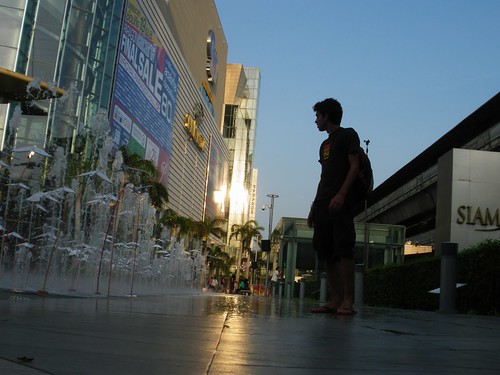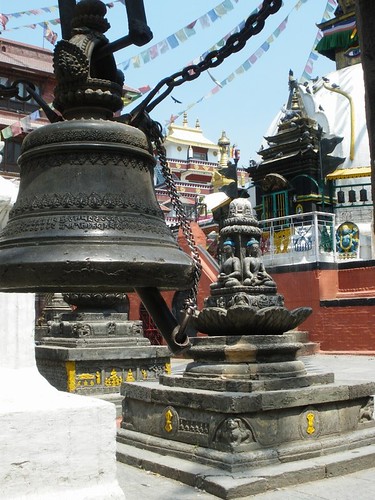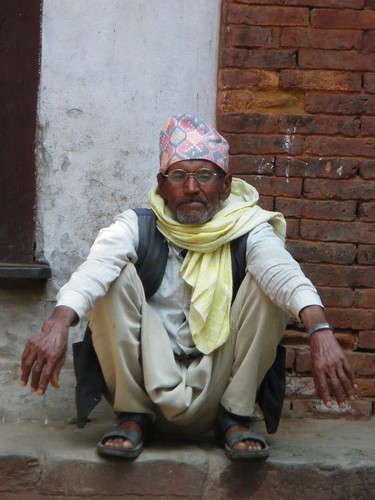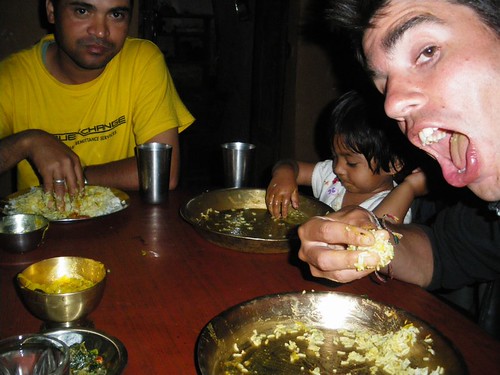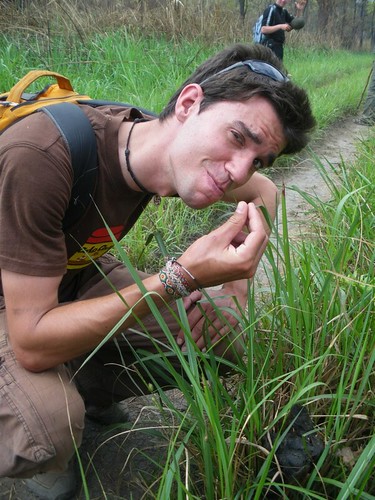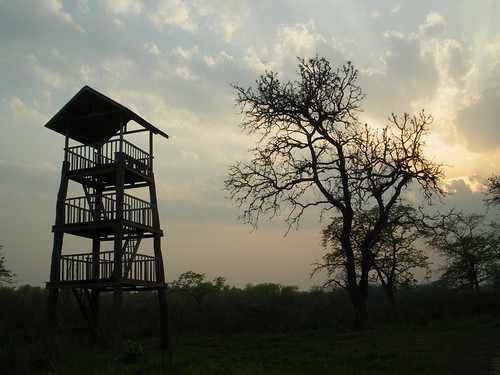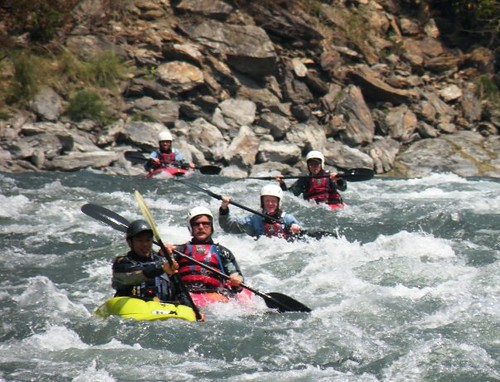The Overstay is a bar/restaurant/lodge/cultural centre aimed at bringing budget travelers and locals together. At this sort of hippie commune -run by an Israeli expat and his Thai girlfriend- one gets the chance to learn very useful things like some Thai language or basic first-aid skills, and others more trivial such as opening beer bottles with almost any random item and demolishing brick walls with a hammer. Although all this was indeed very interesting, my mission at the overstay was to meet people for a trip to the north. And this is how I met Jessica Flores (mid-20s, 88% German, 12% Brazilian). This hyperactive girl moved to Bangkok a couple of years ago and since then she's been working as a journalist, actress, Ebay vendor and volunteer at a hospital among others. Jessi invited me to join her for a short visit to an old friend who lived in a small town near the Lao border. As she spoke of the remoteness and absence of foreigners in the town I knew this was my chance. We arranged the trip that very same evening.
Two days later a luxurious bus (w/ plane-like seats!) dropped us at some point in the middle of a dusty highway. From there a pick-up truck completed the 32 km to Baan Koonsaay. Baan Koonsaay is a 1000-inhabitant town lying in the middle of one of the very few regions of the country not gifted with tourist money. It is not a beautiful town. You won't find anything worth a mention in the Lonely Planet. Nevertheless I bet in a few years Baan Koonsaay will be one of the names in the limited list of Thai towns that I can remember.
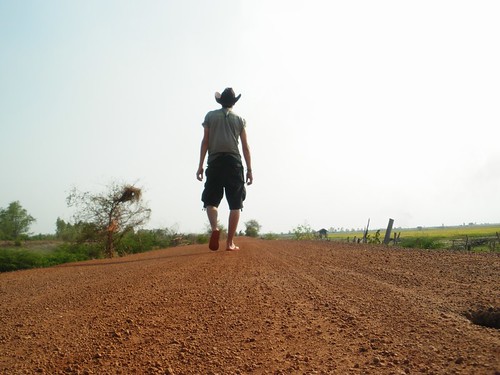 It was in Baan Koonsaay where I could -at last- listen to the B side of Thailand's soundtrack. I had the opportunity to see how things were in Thailand before the hordes of farangs broke in at the end of the 70s. The families here depend exclusively on the harvests (wheat and rice) and the locally produced straw mats that they export to the rest of the country. Our host in town -a girl called Ophol- took us to the fields where I got the chance to join the local farmers in their routines. Only by getting deep in their shoes -which I did NOT- can someone realize how hard the lives of these peoples are. And only then would he or she understand why these people have developed such a loyal and intense relationship with alcohol. A bottle of cold beer is as essential for a farmer as keeping his sickle sharp.
It was in Baan Koonsaay where I could -at last- listen to the B side of Thailand's soundtrack. I had the opportunity to see how things were in Thailand before the hordes of farangs broke in at the end of the 70s. The families here depend exclusively on the harvests (wheat and rice) and the locally produced straw mats that they export to the rest of the country. Our host in town -a girl called Ophol- took us to the fields where I got the chance to join the local farmers in their routines. Only by getting deep in their shoes -which I did NOT- can someone realize how hard the lives of these peoples are. And only then would he or she understand why these people have developed such a loyal and intense relationship with alcohol. A bottle of cold beer is as essential for a farmer as keeping his sickle sharp.But not everything is dry and hard in these peoples' existence, they also have some fun every now and then. Mainly weddings and religious festivities. These events are always a good excuse to leave the farming gear at home and join the rest of the locals for a massive buffet. I testfielded this myself. I don't really know how it happened but my German travelmate and me were invited to the wedding of a young couple.
The Buddhist ceremony was surprisingly similar to the Christian rite. A team of monks leaded the prayers during the day. In the evening all the guests (including us) joined the family for a communal feast comprising all kinds of Thai/Lao food and loads of beer and whiskey. Alright, perhaps these people took it a little further than an average Spanish family. The wedding that I attended featured a stage-trailer with loud speakers and karaoke machine! The groom kicked off followed by a semi-professional singer and a parade of relatives and friends. Needless to say that by that time all the guests were completely drunk -especially the old ladies who send men into exile in the darkest corners of the garden- which elicited lots of volunteers for the singing. I won't go any further in details about the things that happened on the stage that night, I will just add that I hadn't had so much fun since my friend Cry took me to a farmers' party in a tiny village in Lombardia a few years ago. What can I say, old ladies have always been my favorite party mates!
La humedad y los turistas domingueros de la capital me estaban asfixiando, tenia que escapar y tenia que hacerlo pronto. Con esto en mente cruce el rio abandonando el barrio turistico por excelencia hasta que di con el bar/restaurante/hostal The Overstay. En esta comuna hippie uno puede aprender cosas tan interesantes como el lenguaje Thai, primeros auxilios o como abrir una cerveza con casi cualquier objeto. Aunque todo esto es muy interesante mi mision alli no era otra que la de encontrar algun companero de viaje para escapar al norte. Y asi es como conoci a Jessica Flores. Esta alemana afincada en Bangkok me invito a acompanarle en una visita a una vieja amiga que vive cerca de la frontera con Lao. Dos dias mas tarde llegamos a Baan Kosaay. Este pueblo remoto yace en una de las pocas areas libres de turistas del pais. Tal y como pude comprobar sobre el terreno, las familias aqui dependen exclusivamente de las cosechas (arroz y trigo) y de los tapetes/esterillas que exportan al resto del pais. Una vida dura que sobrellevan a base de alcohol. No obstante de cuando en cuando la gente abandona sus quehaceres diarios para celebrar alguna boda o festividad religiosa. No me pregunteis como pero el caso es que mi companera de viaje y yo fuimos invitados a una boda de una joven pareja del pueblo. Aunque la ceremonia (budista) es sorprendemente similar a las bodas catolicas, el banquete y verbena posteriores superan nuestras celebraciones. Es curioso ver como todo el mundo -especialmente las mujeres- se emborrachan y auyentan a los maridos. Digno de mencion es tambien el remolque-karaoke donde familiares y amigos deleitan al personal. No entrare en detalles, pero fue una gran noche la que pase alli.
